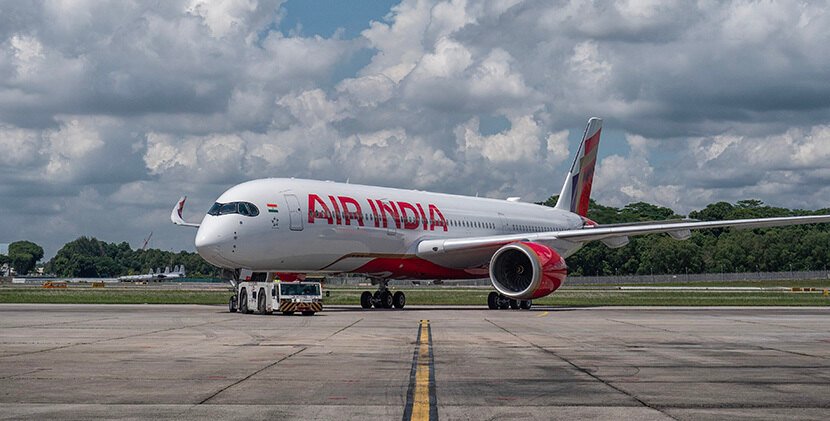Travel Guides & Articles
India Responds To DGCA Show Cause Notice After Air India Flight Time Violations And Regulatory Lapses On International Routes

Published on
August 14, 2025
India’s DGCA has issued a warning to Air India following breaches of flight time regulations on two long-haul flights earlier this year. The violations occurred when both flights from Bangalore to London exceeded the maximum allowable flight time, raising concerns about operational safety. The DGCA emphasized the need for strict adherence to aviation safety standards to ensure passenger well-being and prevent operational lapses, urging the airline to take immediate corrective actions.
The Directorate General of Civil Aviation (DGCA) recently warned Air India about potential violations of flight time regulations concerning two long-haul flights earlier this year. This warning underscores the regulator’s emphasis on the importance of adhering to aviation safety standards and maintaining a high level of care in airline operations, especially in long-distance travel. With Air India expanding its international operations, the DGCA has placed increased scrutiny on the airline’s ability to comply with these safety measures.
On May 16 and 17, 2025, Air India operated two flights between Bangalore and London (AI133). These flights exceeded the 10-hour flight time limit established by the Civil Aviation Requirement (CAR) Section 7, Series J, Part III, which regulates the maximum permissible flight time for pilots. Both flights surpassed the required time frame, which is intended to ensure pilot rest and passenger safety. The DGCA pointed out that such violations could potentially endanger the safety of passengers and flight crews.
Furthermore, the DGCA identified that Air India’s Accountable Manager did not meet the operational requirements set out in Annexure III of the CARs. This section of the regulations outlines the roles and responsibilities of airline management in maintaining safe operations, including proper oversight of flight operations and compliance with safety standards. The DGCA’s concern over this lapse highlights the importance of operational accountability at all levels within an airline.
In response to these regulatory breaches, the DGCA issued a Show Cause Notice to Air India on June 20 under the Enforcement Policy and Procedures Manual (EPPM). This document lays out the procedures for addressing non-compliance with aviation regulations. Following the review of Air India’s response to the notice, the DGCA determined that the airline’s explanation was unsatisfactory in addressing the regulatory lapses and shortcomings. The DGCA emphasized that the airline must adopt a more stringent approach to compliance, underscoring that the management of Air India must “exercise the utmost diligence and responsibility” to ensure full adherence to aviation laws and operational safety.
Air India responded by explaining that the violations were due to a “misinterpretation of a permission granted to alleviate airspace closures caused by border-related issues.” The airline asserted that the problem had been swiftly rectified once the correct interpretation of the permission was communicated to its operations team. In its official statement, Air India reiterated that it is fully aligned with all aviation regulations and that the issue was an isolated incident caused by an incorrect reading of the rules.
While this explanation clarifies the airline’s perspective on the matter, industry experts note that such warnings are not uncommon in the aviation industry. However, they serve as important reminders of the critical need for strict compliance with operational procedures. This is particularly significant for long-haul international flights, where pilot fatigue becomes a greater concern due to extended flight times. Fatigue can impair a pilot’s performance, increasing the risk of operational errors. Ensuring that flight times do not exceed regulatory limits is essential to preventing these risks and safeguarding passenger safety.
The DGCA’s warning also highlights the broader issue of safety management within the airline industry. Long-haul flights, especially those crossing multiple time zones, require careful planning and coordination to ensure that pilots are not overworked and that safety protocols are consistently followed. The DGCA’s decision to issue the Show Cause Notice reflects a broader trend in the aviation sector where regulators are increasingly focused on ensuring that airlines adhere to regulations that safeguard both passengers and crews.
With Air India continuing to expand its international network and increase its global presence, aviation regulators are likely to maintain close oversight of the airline’s operations. The DGCA will probably continue to scrutinize the airline’s compliance with flight safety standards to avoid any future lapses and ensure that passengers receive the highest level of safety during their journeys. As the airline industry grows and the demand for international travel rises, regulators will undoubtedly prioritize operational safety to avoid incidents that could jeopardize public trust in air travel.
As Air India moves forward, it is clear that the airline must take proactive steps to improve its internal processes and ensure that it meets all regulatory requirements without fail. The airline’s management must prioritize safety and compliance, especially as it expands its route network and handles an increasing volume of flights. By adhering strictly to aviation safety standards and regulations, Air India can maintain its reputation as a reliable and safe airline, fostering trust with passengers and regulatory bodies alike.
India’s DGCA has warned Air India after two long-haul flights exceeded the maximum allowable flight time, highlighting concerns over safety and emphasizing the need for strict regulatory compliance.
In conclusion, the DGCA’s warning to Air India serves as a crucial reminder of the importance of flight safety regulations, particularly in long-haul international operations. The airline industry must continue to prioritize operational oversight, especially regarding flight time limitations, to ensure that pilots are well-rested, fatigue is minimized, and passenger safety remains the top priority. As global travel continues to grow, so too must the commitment to maintaining high safety standards across the aviation industry.
Travel Guides & Articles
India travel update: Citizens of these neighbouring countries no longer require to carry passport or visa to enter India |

In a bid to promote cross-border tourism, the Indian Ministry of Home Affairs (MHA) has announced that citizens of Nepal and Bhutan can enter India without a passport or visa starting September 1, 2025. The Immigration and Foreigners (Exemption) Order, 2025, allows citizens of Nepal and Bhutan to enter India when arriving by land or air through their respective borders (without a passport or visa). The MHA informed, the requirement of a passport or any other travel documents, a visa for entry into, stay in and exit from India shall not apply if “a citizen of India entering into India by land or by air over the Nepalese or Bhutanese frontier, a citizen of Nepal or Bhutan entering into India by land or air over the Nepal or Bhutan border or if he possesses a valid passport while entering or exiting India from or to a place other than Nepal or Bhutan but not from China, Macau, Hong Kong or Pakistan”.As per the MHA’s notification under Section 33 of the Immigration and Foreigners Act, 2025:Citizens of Nepal and Bhutan coming by land or air from their respective countries are not required to show a passport or visa.The rule is also applicable to Indian nationals entering India by land or air via Nepal or Bhutan.However, citizens of Nepal and Bhutan must carry valid passports and visas if entering from any third nation—except if arriving with such documents from China, Macau, Hong Kong, or Pakistan.Identity Documentation
Nepali and Bhutanese citizens still need to carry valid identity proof such as:Citizenship certificateVoter ID (issued by the Election Commission of their country)Limited-validity photo-ID issued by their mission in IndiaFor kids aged 10–18, a school principal’s photo-ID accompanying parents; no ID required for children under 10Extended Exemptions under the New Order
The 2025 exemption consolidates and replaces earlier provisions (1957 and 2007 orders), and also extends passport and visa relaxations to:Members of Indian Armed Forces, along with their families when travelling on government transport Registered Tibetans who entered via Special Entry Permits issued by the Indian Embassy in Kathmandu, both before and after May 30, 2003 Minority community refugees (Hindus, Sikhs, Buddhists, Jains, Parsis, Christians) from Afghanistan, Pakistan, and Bangladesh who entered India on or before December 31, 2024, regardless of whether their travel documents are valid or expired Registered Sri Lankan Tamils who took shelter in India on or before January 9, 2015Impact on travellersNow Nepali and Bhutanese tourists and travellers planning to explore India can do that without worrying about a passport or visa. For tourism or personal visits, citizens from Nepal and Bhutan can directly enter from their home country using alternate IDs. This will simplify the documentation process and boost cross-border connectivity, trade, and ties while preserving national security.
Travel Guides & Articles
Thomas Cook India, SOTC Travel team up with Queensland to boost tourism from India

Thomas Cook (India) and its group company, SOTC Travel, have signed a long-term memorandum of understanding with Tourism and Events Queensland to encourage travel from India to Queensland, Australia.
The agreement will cover content, education and training programmes and joint marketing, using Thomas Cook India and SOTC Travel’s digital platforms and retail network to promote Queensland as a destination for leisure, meetings and incentives, business and sports tourism across metro and regional markets in India.
The agreement was signed by senior leadership from Thomas Cook (India) and SOTC Travel with Katie Mills, international director at Tourism and Events Queensland, in the presence of David Crisafulli, premier of Queensland and minister for veterans.
Queensland offers a range of experiences for visitors, from UNESCO World Heritage sites such as the Great Barrier Reef and the Daintree Rainforest to the Gold Coast’s beaches and theme parks, the Whitsundays’ island stays and sailing, and Brisbane’s riverfront precincts and dining. Cairns and Port Douglas serve as gateways for reef and rainforest exploration. The state attracts families, couples, younger travellers and business groups, with sports tourism also a focus, including interest in cricket and the 2032 Brisbane Olympic Games.
Craig Davidson, CEO of Tourism and Events Queensland, commented: “This strategic connection with Thomas Cook India and SOTC Travel is a powerful step forward in our mission to position Queensland as the destination of choice for India travellers. Through collaborative marketing, education and content creation, we’re excited to inspire more India visitors to discover ‘Australia’s Holiday Feeling’, which can only be experienced in Queensland.”
“Our intent is to create innovative, immersive, experience-led itineraries that appeal to our range of segments across multi-generational families, millennials and Gen Z, couples, working professionals and our powerful MICE corporates,” said Rajeev Kale, president and country head – holidays, MICE, Visa, Thomas Cook (India).
S D Nandakumar, president and country head – holidays and corporate tours, SOTC Travel, added: “Our strategy will focus on the key pivots of product development, education and marcom – we intend to spotlight Queensland’s iconic natural beauty while also showcasing the state’s hidden gems and exciting experiences – ensuring truly memorable and repeat visitations.”
Travel Guides & Articles
Brazil, Mexico, China And India In Facing New US Visa Integrity Fee Of Two Hundred Fifty Dollars For All Foreign Travelers – Travel And Tour World
-

 Business6 days ago
Business6 days agoThe Guardian view on Trump and the Fed: independence is no substitute for accountability | Editorial
-
Tools & Platforms3 weeks ago
Building Trust in Military AI Starts with Opening the Black Box – War on the Rocks
-

 Ethics & Policy1 month ago
Ethics & Policy1 month agoSDAIA Supports Saudi Arabia’s Leadership in Shaping Global AI Ethics, Policy, and Research – وكالة الأنباء السعودية
-

 Events & Conferences4 months ago
Events & Conferences4 months agoJourney to 1000 models: Scaling Instagram’s recommendation system
-

 Jobs & Careers2 months ago
Jobs & Careers2 months agoMumbai-based Perplexity Alternative Has 60k+ Users Without Funding
-

 Education2 months ago
Education2 months agoVEX Robotics launches AI-powered classroom robotics system
-

 Funding & Business2 months ago
Funding & Business2 months agoKayak and Expedia race to build AI travel agents that turn social posts into itineraries
-

 Podcasts & Talks2 months ago
Podcasts & Talks2 months agoHappy 4th of July! 🎆 Made with Veo 3 in Gemini
-

 Podcasts & Talks2 months ago
Podcasts & Talks2 months agoOpenAI 🤝 @teamganassi
-

 Education2 months ago
Education2 months agoAERDF highlights the latest PreK-12 discoveries and inventions






















